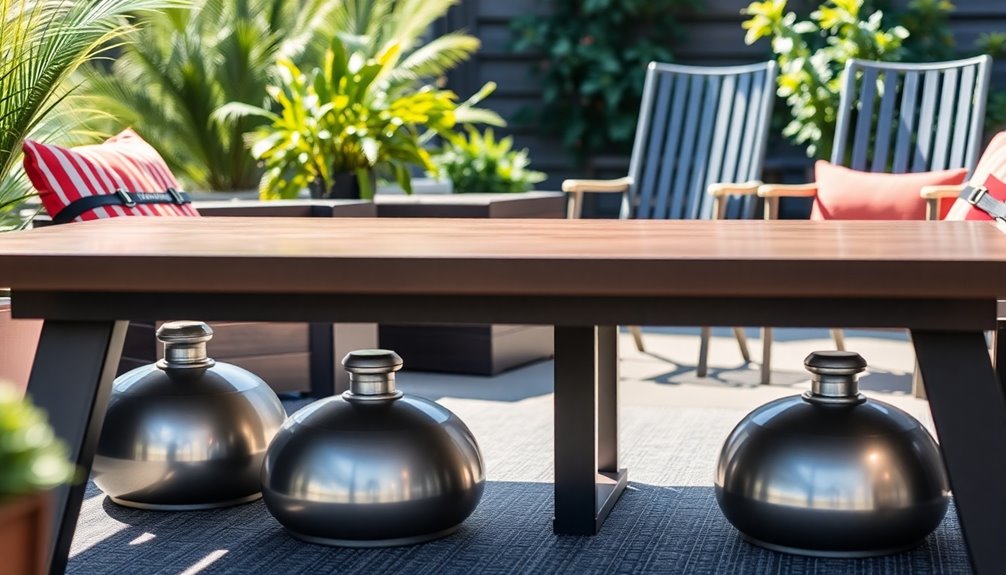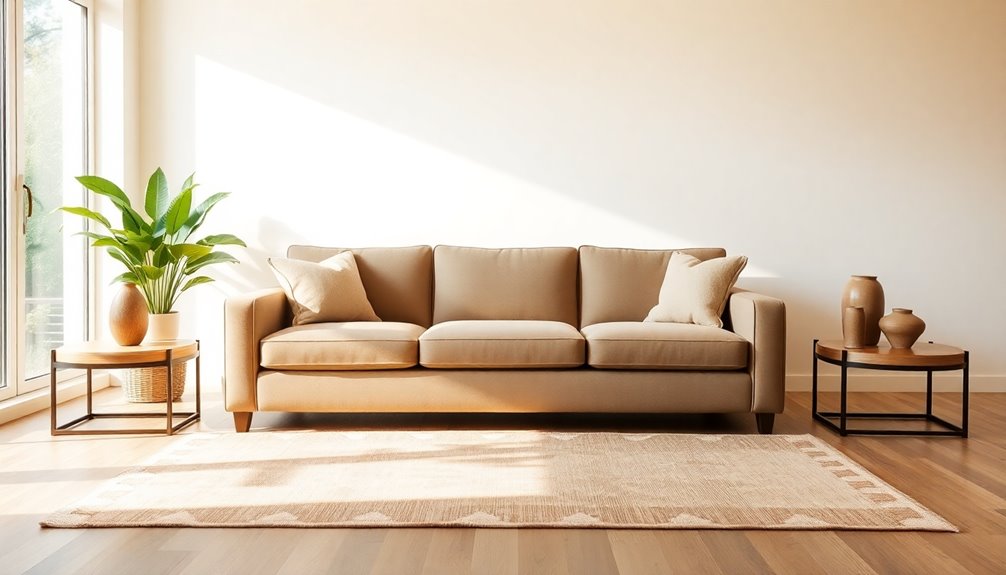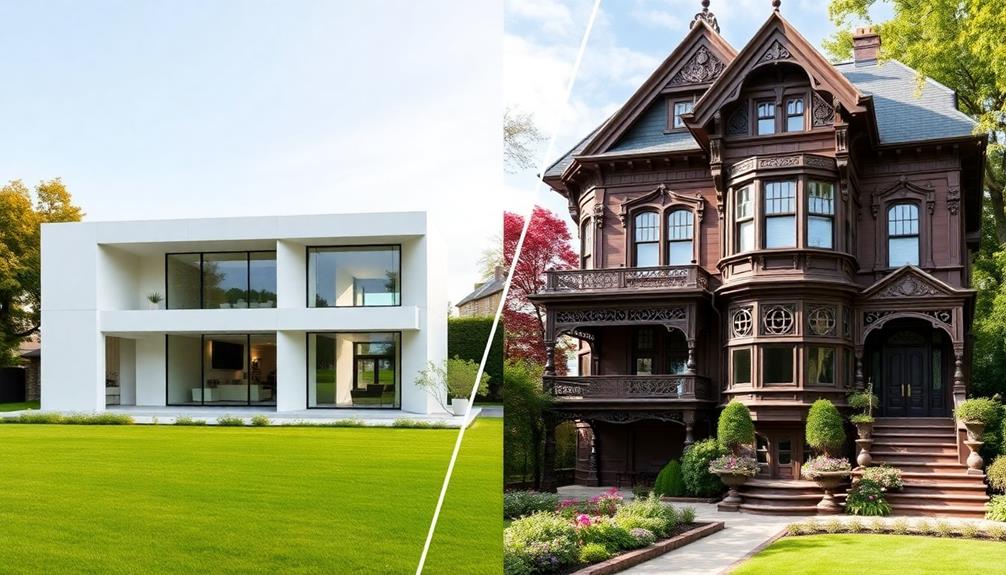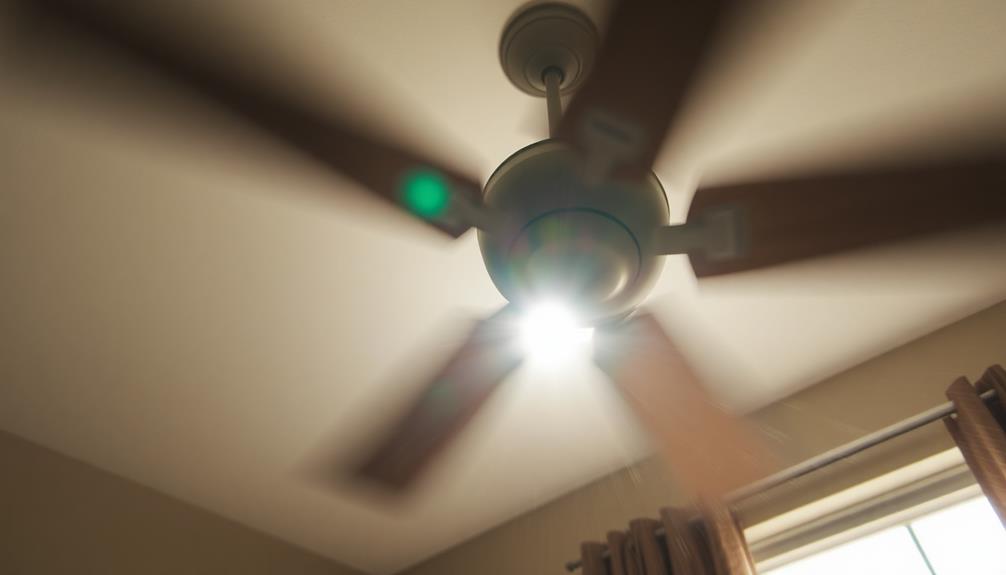To keep your patio furniture from blowing away, start by anchoring it securely. Use stakes for grass or sandbags on patios. Incorporate anti-blow away accessories like weighted covers and heavy-duty straps. Opt for durable, heavier materials like metal or stone for your furniture, and arrange items near walls or hedges to reduce wind impact. Don't forget to fasten cushions with Velcro or tie-downs, and cover everything when storms approach. Regularly check the weather and stay proactive about securing your setup. There's plenty more you can do to fortify your outdoor space further.
Key Takeaways
- Anchor furniture using stakes, screws, or adhesive anchors to secure it to the ground or deck, preventing movement during strong winds.
- Use weighted accessories like sandbags or weight bags to stabilize furniture covers and prevent them from lifting.
- Opt for heavy, durable furniture made from materials like metal or concrete for enhanced stability against wind forces.
- Place furniture strategically near walls or hedges to utilize natural barriers that reduce wind exposure and protect items.
- Regularly monitor weather conditions and take quick protective measures, such as securing loose items or using covers during strong winds.
Anchor the Furniture
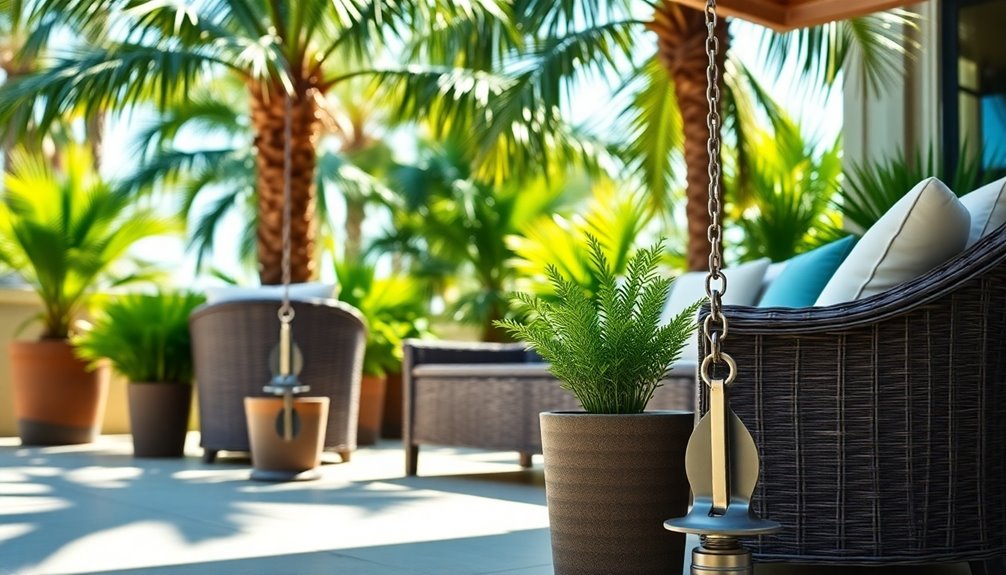
Anchoring your patio furniture is essential for preventing it from blowing away during strong winds. Start by selecting the right anchors based on your furniture type and the outdoor surface. If you're dealing with soil or grass, drive stakes into the ground through the legs or base of your furniture. For heavier items like tables or large planters, use concrete anchors or heavy-duty L-brackets to ensure stability.
On wooden decks, opt for anchors that screw directly into the boards. If you have a patio, adhesive anchors that stick with glue can save you from drilling. It's crucial to use heavy-duty bolts and screws made for outdoor use, preferably corrosion-resistant materials like steel or galvanized metal for durability. Additionally, patio furniture theft is a common issue that can lead to significant financial loss, so securing your furniture is doubly important.
To enhance security, consider anchoring your furniture to stable structures such as trees or poles. You can also use steel cables and padlocks to secure multiple pieces together. Make sure to install the anchors firmly and test the system to confirm it's secure. Regularly check for wear or damage to maintain long-term security, ensuring your furniture stays put no matter how strong the winds get.
Use Anti-Blow Away Accessories
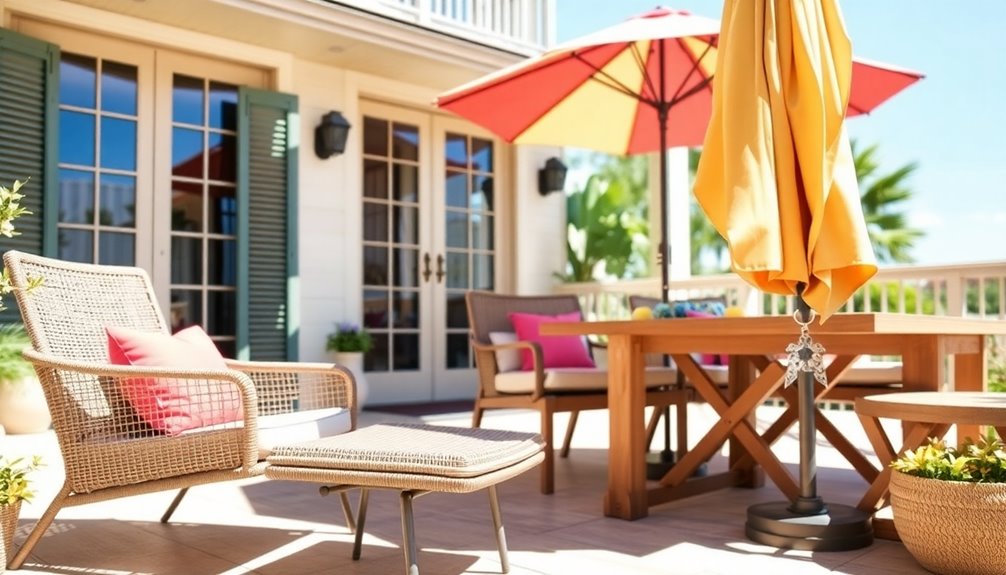
Even with the best anchors, strong winds can still pose a threat to your patio furniture. To fortify your setup, consider using anti-blow away accessories. Weighted accessories like weight bags can be placed on the edges of your furniture covers to prevent them from lifting. Sandbags filled with sand, gravel, or rocks can also add stability to your patio furniture's base. You might even use bricks or heavy objects as makeshift weights.
Additionally, heavy-duty straps made of nylon can secure individual pieces of furniture and prevent them from blowing away. Bungee cords are great for attaching to cover grommets, providing extra stability during gusty conditions. Don't forget about furniture clamps, which can hold your furniture together and secure legs to the ground. They're especially useful for lightweight items.
Finally, installing wind-resistant hardware, like covers with strong ties and adjustable straps, can help keep everything in place. Look for innovative solutions from reputable brands that offer durable and wind-resistant designs. By using these accessories, you can significantly reduce the chances of your patio furniture getting tossed around in the wind. Using heavier materials is recommended as they can resist wind better, ensuring the stability of your outdoor setup.
Secure Cushions and Fabrics
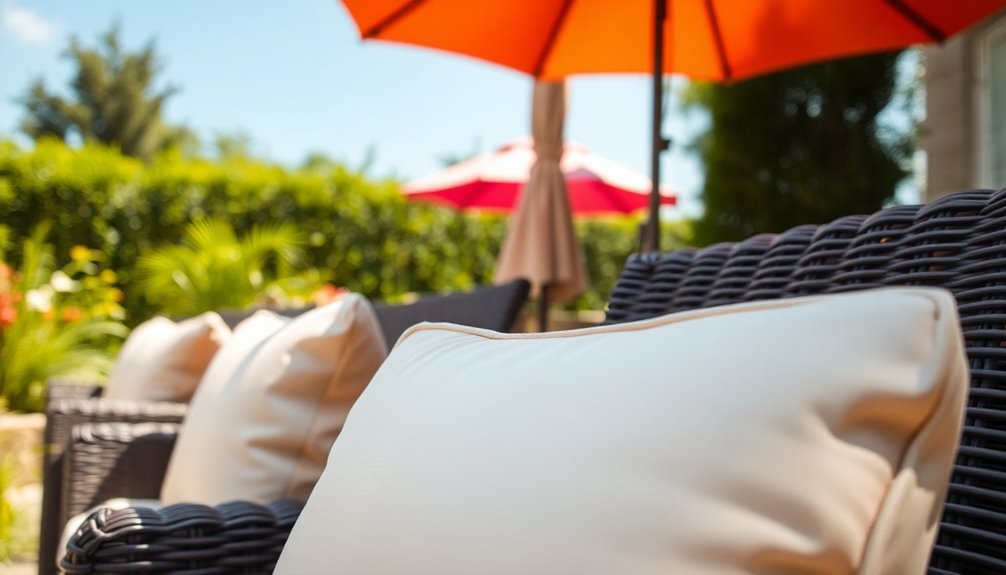
To keep your cushions and fabrics secure against gusty winds, it's essential to use effective fastening methods. One reliable option is Velcro strips. Simply attach one side to your cushions and the other to the furniture. Make sure the Velcro is firmly in place and check it regularly to ensure it's still gripping well. Replace the strips when they start to lose their stickiness. Additionally, consider using waterproof covers for cushions when not in use to provide extra protection against wind and rain. This not only keeps items secure but also promotes mindful consumption, as it helps prolong the life of your outdoor furnishings.
If you prefer a DIY approach, consider using ties made from materials like bias tape or ribbon. Mark where you’ll attach the ties on the furniture frame, then punch holes in the fabric. Use Fray Check to prevent fraying, and secure the ties with buttons or knots for added stability. You can also personalize the design by choosing ties that complement your decor. Once the ties are securely attached, test their durability to ensure they can withstand regular use. If you’re planning to make significant modifications, it’s helpful to know how to disassemble a sofa to access the internal structure and make any necessary adjustments to the frame.
Bungee cords are another great solution. Position your cushions on the furniture and use multiple cords to keep them tightly held. This method can also help group furniture together, creating a heavier cluster that's more resistant to wind. Just be cautious that the cords don't damage your cushions or furniture. Adjust the tension based on wind conditions for optimal security.
Utilize Furniture Covers
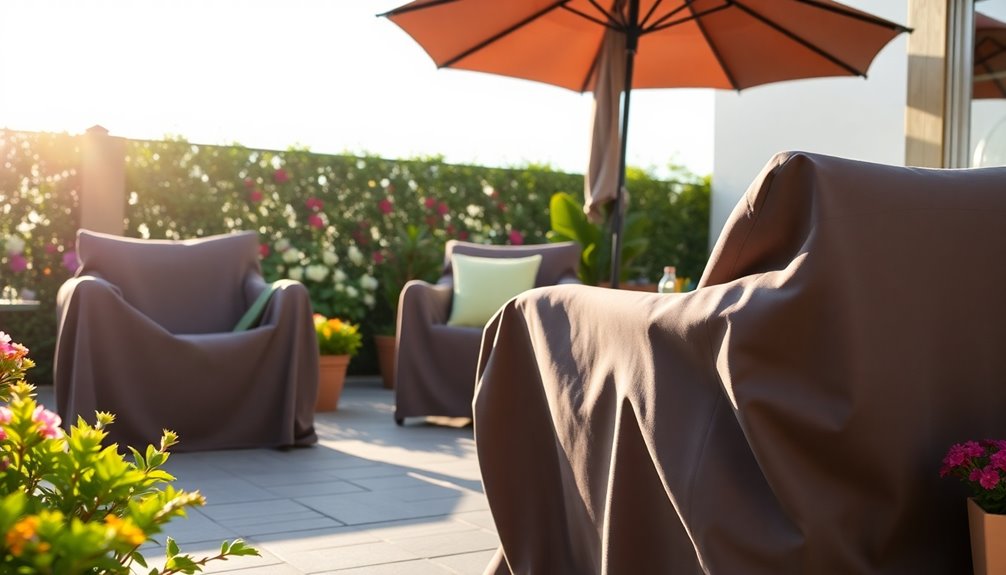
After securing your cushions and fabrics, protecting your entire patio furniture set with high-quality covers is a smart move against strong winds. Choose covers made from durable, weather-resistant materials like vinyl, polyester, or canvas. Make sure the covers fit tightly to prevent wind from lifting them. Opt for covers with advanced technologies like SEAL-TEC for added protection against wind, sun, and moisture.
Look for UV-resistant properties to maintain your furniture's color and structural integrity. Breathable covers are also essential to prevent mold, mildew, and musty odors. Additionally, using a moisture barrier in your covers will help keep your furniture dry and safe from rain and spills.
To keep your covers securely in place, use weights, straps, or clips. Attach bungee cords to the cover grommets for extra stability, and consider placing heavy objects like bricks on the edges.
Regularly check your covers to ensure they're installed correctly and remain tight. If you notice any damage, promptly repair them to ensure long-lasting protection. Brands known for wind-resistant covers, such as Duck Covers and Classic Accessories, often feature strong ties and adjustable straps, providing you with the durability and aesthetic appeal you need to withstand harsh weather conditions.
Opt for Heavy, Durable Furniture
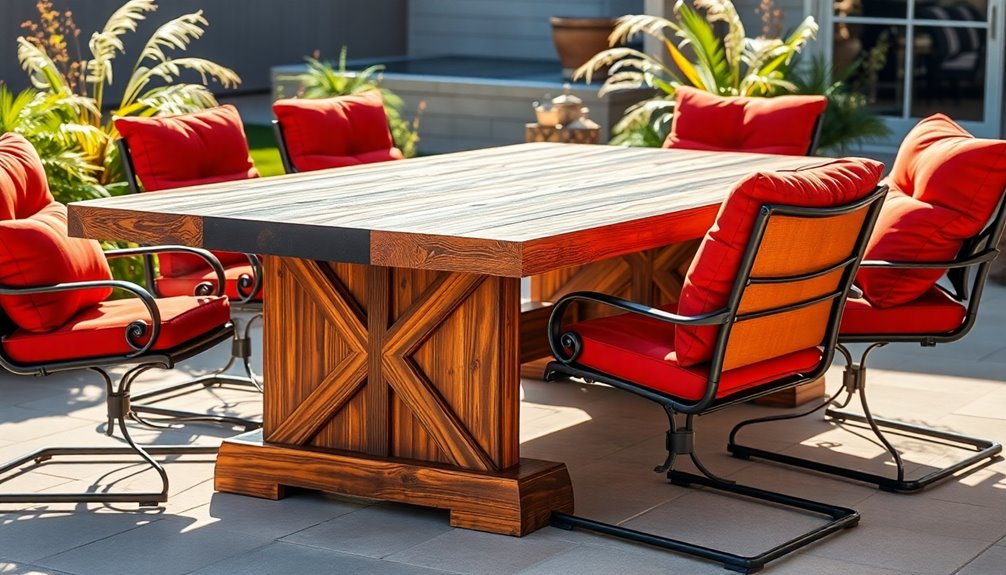
Opting for heavy, durable furniture is a game-changer when it comes to keeping your patio set secure during strong winds. Choosing materials like metal, concrete, or stone gives you the stability you need. These heavy-duty options resist wind better than lightweight pieces such as plastic chairs or aluminum tables. Consider furniture made from cast aluminum, wrought iron, or steel, as their weight and strength make them effective choices.
Additionally, selecting pieces with sturdy frames and bases further enhances stability. Wicker chairs with metal frames or furniture made from solid HDPE lumber are less likely to be blown away. For extra durability, look for pieces with 316 marine-grade stainless steel fasteners. Plus, investing in heavy-duty patio furniture ensures that your outdoor pieces can withstand strong winds while maintaining their functionality and aesthetic appeal. Regular maintenance, such as routine inspections, can further extend the life of your furniture.
When you think about specific designs, opt for heavy Adirondack chairs or dining sets made from solid materials. Deep seating furniture, like club chairs and sofas, also provides more stability. You might even consider adding weights like sandbags to bases or stacking lightweight chairs together to increase overall weight. By focusing on heavy, durable furniture, you'll significantly reduce the risk of your patio set being lifted away by strong winds.
Employ Landscaping and Windbreaks
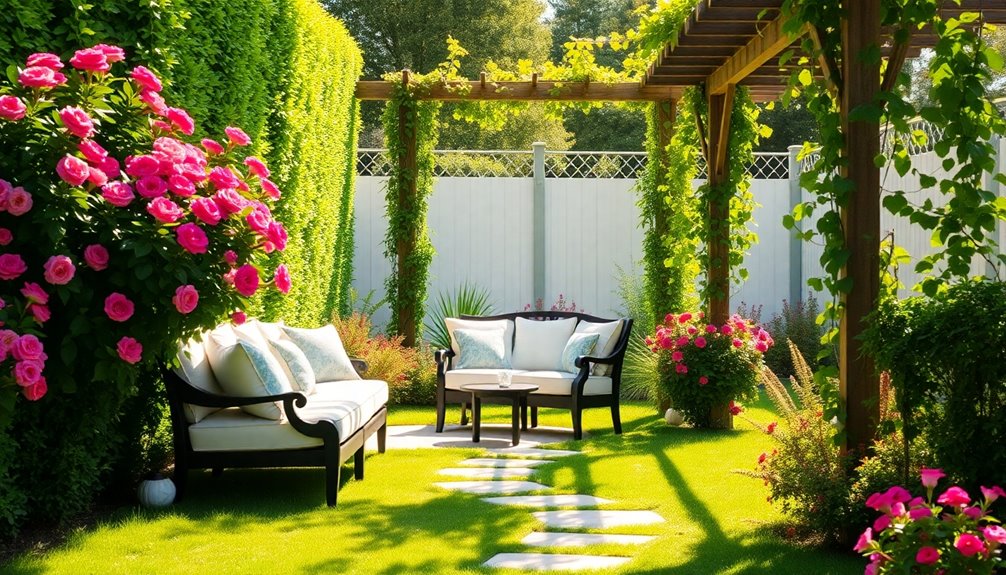
Utilizing landscaping and windbreaks can be an effective way to shield your patio furniture from strong gusts. By selecting thick plants or trees like vertical yews or dense shrub hedges, you can create a natural barrier that blocks 25% to 60% of the wind. Not only do these windbreaks provide protection, but they also enhance your patio's aesthetic, offering privacy and shade.
If you opt for shrub hedges, choose dense needled evergreens, as they're more effective than broadleaf varieties. These hedges can be tailored to fit your space and, while they may require some investment in terms of cost and labor, they're a long-term solution that can grow more effective over time. Additionally, windrows of trees can significantly alter the microclimate and protect larger areas, making them an excellent choice for extensive outdoor spaces. Heavy furniture can also be strategically placed near these plants to further anchor your setup against strong winds.
For a more immediate solution, consider incorporating built wind screens made from materials like wood or fiberglass. These can be designed to complement your decor while providing privacy. By employing these landscaping techniques, you'll effectively safeguard your patio furniture against unpredictable winds.
Choose Proper Placement
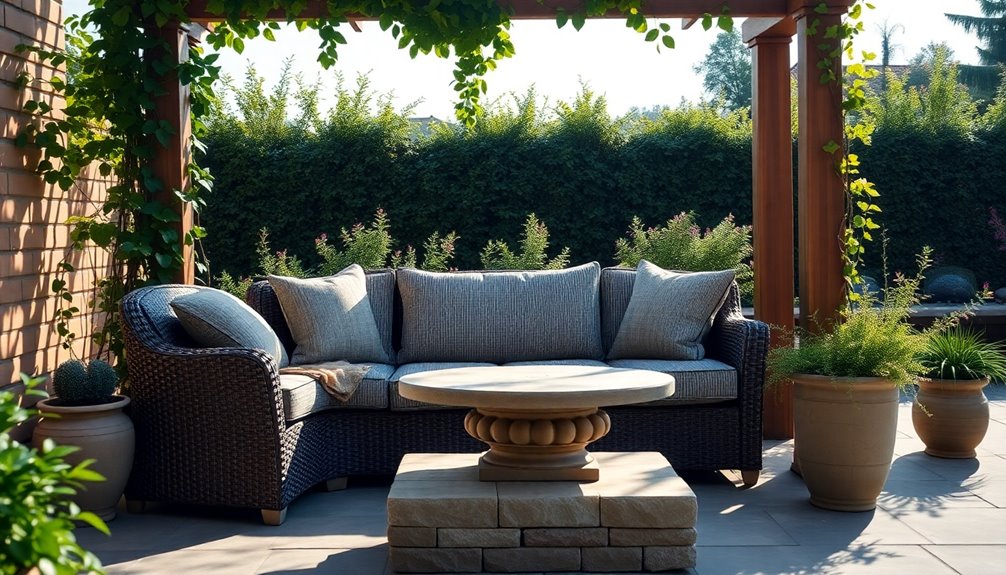
Landscaping and windbreaks can significantly reduce wind exposure, but proper placement of your patio furniture is equally important. Start by positioning your furniture near walls, fences, or other structures that act as natural barriers against the wind. Look for sheltered areas, such as corners or spots protected by overhanging eaves, to keep your pieces safe from strong gusts.
Take the time to observe the wind patterns in your area. Identify where the wind tends to blow from and adjust your furniture accordingly. Place heavier items in areas that face the most wind and avoid spots known for high wind activity. Additionally, consider how different materials can affect your furniture's vulnerability to wind.
Utilize existing barriers like garden features, hedges, or lattice panels to create additional windbreaks. When arranging your furniture, consider forming a U-shape with larger pieces to deflect wind and anchor lighter items behind them. Grouping furniture together instead of isolating it can also minimize the risk of pieces being blown away.
Finally, ensure that your arrangement allows for easy anchoring or weighting down if necessary. With thoughtful placement, you can significantly enhance the stability of your patio furniture.
Regular Maintenance Practices
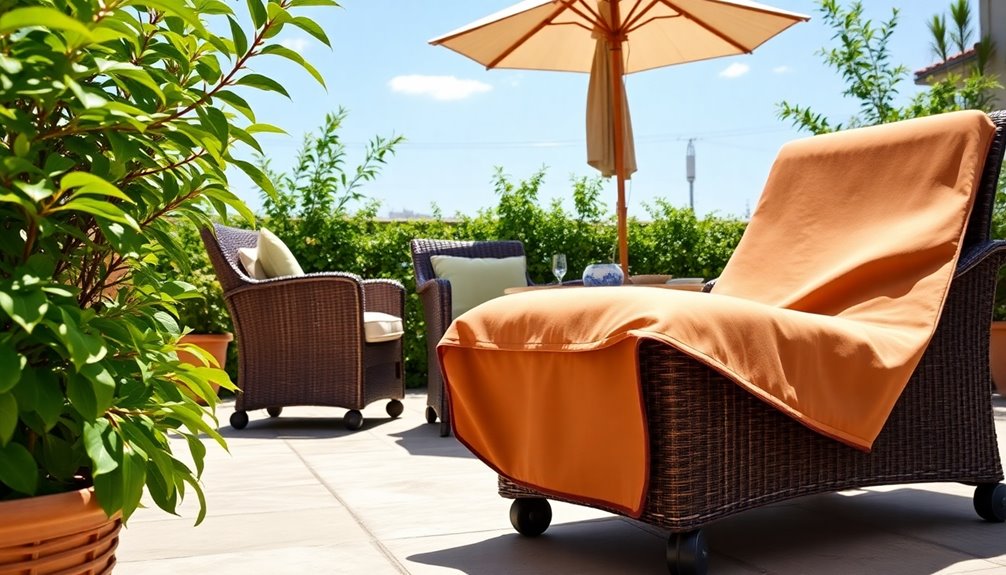
Regular maintenance practices are essential for keeping your patio furniture in top shape and preventing damage from the elements. Start by cleaning your furniture regularly. For metal pieces, mix mild soap with water and scrub gently with a soft brush to remove dirt. Rinse and dry thoroughly to avoid rust. Wooden furniture requires a similar approach; use a mild detergent solution and a soft cloth, then apply a wood sealant to protect against moisture and UV rays. Regular cleaning prevents the buildup of dirt and grime, prolonging furniture life.
Seasonal maintenance is equally important. In the spring, wipe away winter grime and inspect for any damage, such as chipped paint or loose screws. Apply a fresh protective finish as needed. Store your furniture indoors or cover it during harsh weather to prevent deterioration.
Finally, always keep an eye on your furniture's condition. Regularly check for wear and tear, addressing any issues promptly. This proactive approach not only enhances the longevity of your furniture but also ensures it remains secure against the elements. By following these regular maintenance practices, you'll enjoy a beautiful and functional outdoor space for years to come.
Monitor Weather Conditions
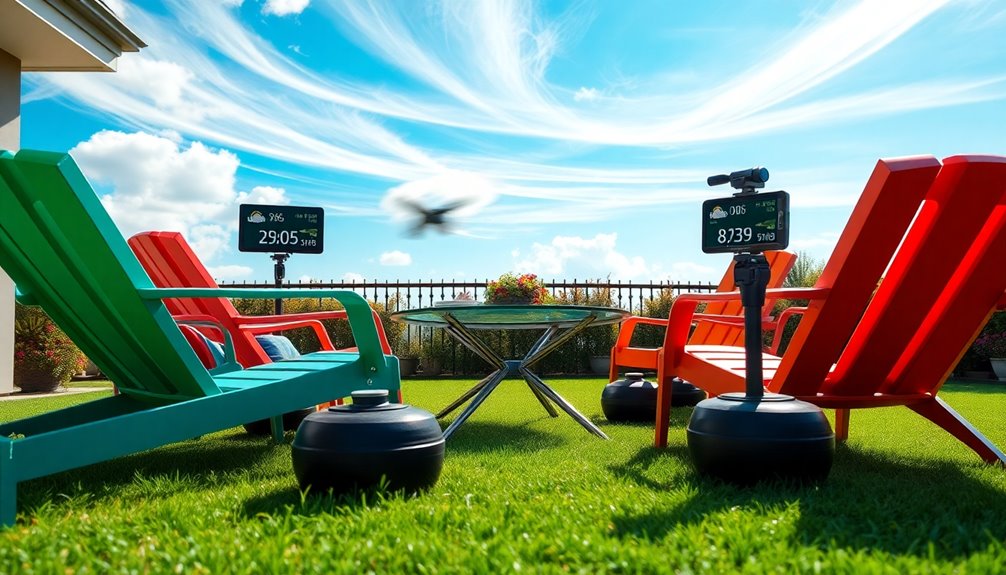
Keeping an eye on weather conditions is vital to protecting your patio furniture from strong winds. Start by checking local weather reports for wind warnings and forecasts. Utilize weather apps to receive real-time updates, ensuring you're always informed. Consider signing up for emergency alerts from local authorities to stay ahead of any severe weather. Reviewing historical weather data can also help you anticipate seasonal wind patterns.
When strong winds are expected, take proactive measures. Bring in loose patio items or secure them tightly if you can't move them indoors. Use weights or anchors to stabilize furniture that remains outside, and don't forget to secure outdoor decorations and plants, as they can become dangerous projectiles. Properly-fitted covers can also enhance protection against high winds.
Adjust your furniture arrangements, placing items in corners or near walls to minimize their exposure. Stack lightweight chairs and tables for added stability, and consider using natural windbreaks like fences or hedges.
Finally, implement last-minute measures before leaving the area. Quick fixes like sandbags or Velcro strips can provide extra support, ensuring that your furniture stays intact, no matter how fierce the winds get.
Frequently Asked Questions
What Types of Furniture Are Most Prone to Blowing Away?
When considering which types of furniture are most prone to blowing away, lightweight materials like plastic chairs and aluminum tables often come to mind. Wicker furniture without metal frames and stackable plastic chairs can also be easily displaced by strong winds. Additionally, items with broad surfaces or tall designs are more susceptible. If your furniture isn't anchored or weighted down, it's at an even greater risk of being blown away in gusty conditions.
How Can I Prevent Furniture From Rusting Due to Moisture?
To prevent your furniture from rusting due to moisture, cover it with waterproof covers when not in use. Regularly dry off any rainwater and clean it using mild soap to keep mildew at bay. Consider applying anti-rust sprays or protective coatings on metal surfaces for extra defense. Invest in rust-resistant materials, like aluminum or stainless steel, to ensure your furniture lasts longer and stays looking great despite the elements.
Are There Specific Brands Known for Wind-Resistant Patio Furniture?
When searching for wind-resistant patio furniture, consider brands like Telescope Casual, which offers heavy-duty aluminum pieces, and Seaside Casual, known for its durable recycled materials. Polywood is another great option, featuring solid, weather-resistant HDPE. Additionally, look into Hanover's line of furniture, designed with stability in mind. These brands provide stylish options that combine aesthetics with functionality, ensuring your outdoor space remains secure even in breezy conditions.
How Often Should I Check My Furniture's Stability?
You should check your furniture's stability at least once a season, focusing on joints, screws, and any moving parts. After storms, do a thorough inspection to ensure everything's still secure and undamaged. Monthly maintenance is essential, too; clean your furniture and tighten any loose screws or bolts. Daily observations help you catch any issues early, so stay vigilant and adjust your furniture as needed based on the weather conditions.
Can I Use Furniture Indoors During Bad Weather?
Absolutely, you can use furniture indoors during bad weather! It's a smart move to protect your pieces from damage. Just ensure you have enough space to store them comfortably. If you're dealing with heavy or bulky items, consider disassembling them for easier movement. Don't forget to clean and dry the furniture before bringing it inside. This way, you'll keep everything in good condition and ready for use when the weather clears up.
Conclusion
By following these tips, you can keep your patio furniture safe from strong winds. Anchor it down, use accessories to secure it, and opt for heavier pieces to withstand gusts. Don't forget to cover your furniture and keep cushions in check. Creating windbreaks with landscaping and choosing the right placement also makes a big difference. Regular maintenance and keeping an eye on the weather can help protect your outdoor space. Enjoy your patio without worry!
